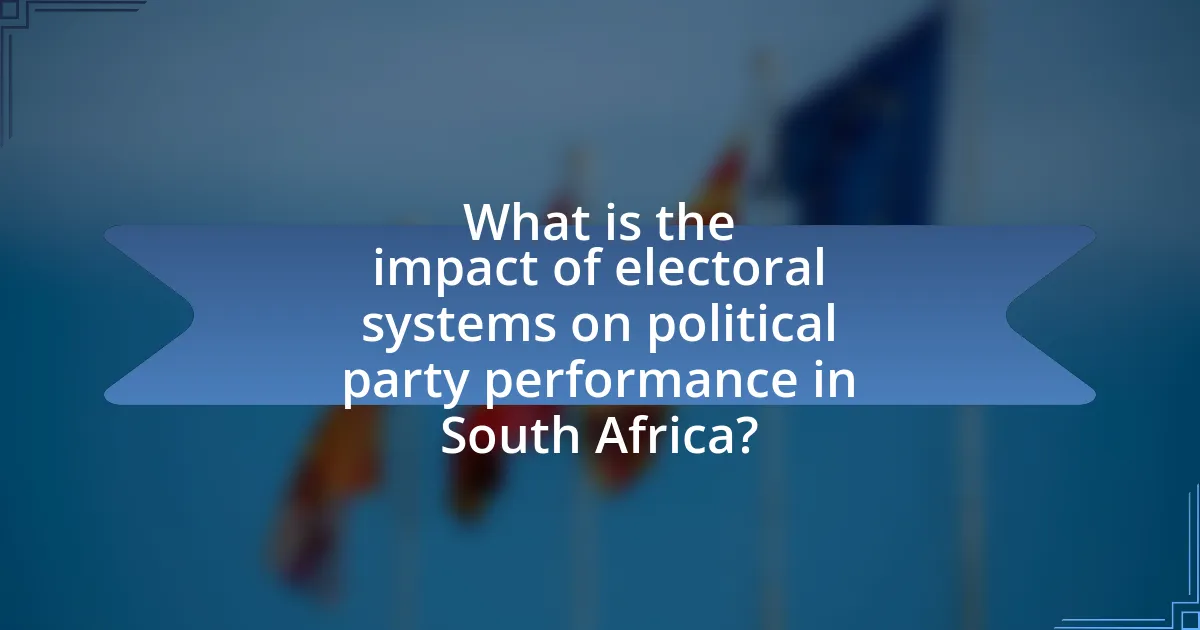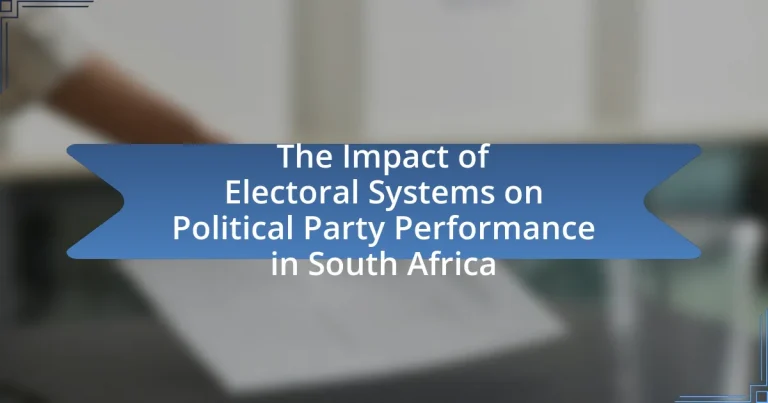The article examines the significant impact of electoral systems on political party performance in South Africa, focusing on the proportional representation model established post-apartheid. It outlines how this system facilitates a multi-party democracy, allowing diverse political representation and influencing party strategies, voter behavior, and coalition dynamics. Key features of South Africa’s electoral system, historical contexts, and the evolution since 1994 are discussed, along with the challenges faced by political parties and potential reforms to enhance representation and governance. The article also highlights best practices for political parties to navigate the electoral landscape effectively.

What is the impact of electoral systems on political party performance in South Africa?
The impact of electoral systems on political party performance in South Africa is significant, as the proportional representation system used in national and provincial elections allows for a diverse range of parties to gain representation. This system, established in the post-apartheid era, enables smaller parties to enter the political landscape, which has led to a multi-party system where parties like the African National Congress, Democratic Alliance, and Economic Freedom Fighters compete for power. The proportional representation model has resulted in a fragmented political environment, where coalition-building becomes essential for governance, influencing party strategies and voter alignment. For instance, in the 2019 national elections, the ANC secured 57.5% of the vote, while the DA and EFF garnered 21.1% and 10.8%, respectively, illustrating how the electoral system shapes party performance and voter representation.
How do different electoral systems function in South Africa?
South Africa employs a proportional representation electoral system, specifically the party-list system, which allows voters to select parties rather than individual candidates. This system ensures that the number of seats a party receives in the National Assembly is proportional to the number of votes it secures, promoting a multi-party democracy. For instance, in the 2019 national elections, the African National Congress received 57.5% of the votes, translating to 230 out of 400 seats in the National Assembly, illustrating the direct correlation between votes and representation. Additionally, the electoral system includes a mixed-member proportional representation component for provincial legislatures, further enhancing proportionality and inclusivity in governance.
What are the key features of South Africa’s electoral systems?
South Africa’s electoral system is characterized by a proportional representation model, which ensures that political parties gain seats in the National Assembly in proportion to the number of votes they receive. This system promotes a multi-party democracy, allowing for a diverse representation of political views. The key features include a single national ballot for voters, a threshold of 0.25% for parties to gain representation, and the use of a closed-list system where voters select parties rather than individual candidates. The Electoral Act of 1998 governs these processes, ensuring fairness and transparency in elections.
How do these features influence party representation?
Electoral system features significantly influence party representation by determining how votes translate into seats in the legislature. For instance, South Africa employs a proportional representation system, which allows smaller parties to gain representation in Parliament relative to their share of the vote, thereby enhancing diversity in political representation. This system contrasts with majoritarian systems, where larger parties often dominate, limiting the representation of minority viewpoints. The 2019 national elections in South Africa exemplified this, as 14 parties secured seats in the National Assembly, reflecting a broader spectrum of political opinions compared to a winner-takes-all approach.
Why is understanding electoral systems important for political parties?
Understanding electoral systems is crucial for political parties because these systems directly influence their ability to gain representation and achieve electoral success. Electoral systems determine how votes are translated into seats, affecting party strategies, campaign focus, and voter engagement. For instance, in South Africa, the proportional representation system allows smaller parties to gain seats in the National Assembly, which can lead to a more diverse political landscape. This understanding enables parties to tailor their platforms and outreach efforts effectively, maximizing their chances of winning votes and forming coalitions.
How do electoral systems affect party strategies and campaigning?
Electoral systems significantly influence party strategies and campaigning by determining how votes translate into seats. In South Africa, the proportional representation system encourages parties to form coalitions, leading them to focus on broad appeal and inclusive platforms to attract diverse voter bases. This system contrasts with majoritarian systems, where parties may prioritize winning specific geographic areas, often resulting in targeted campaigning. For instance, the 2019 elections saw parties like the African National Congress and the Democratic Alliance tailoring their messages to resonate with various demographic groups, reflecting the need for a wide-ranging strategy to secure representation in a proportional context.
What role do electoral systems play in voter behavior?
Electoral systems significantly influence voter behavior by shaping how individuals perceive their voting power and the overall electoral process. For instance, proportional representation systems tend to encourage higher voter turnout as citizens feel their votes contribute to the overall outcome, while winner-takes-all systems may lead to voter apathy, particularly among those in minority parties. Research indicates that in South Africa, the mixed-member proportional system has resulted in diverse party representation, which can enhance voter engagement and satisfaction. This is supported by data showing that in the 2019 elections, voter turnout was approximately 65%, reflecting the impact of the electoral system on mobilizing citizens to participate in the democratic process.
What are the historical contexts of electoral systems in South Africa?
The historical contexts of electoral systems in South Africa are rooted in the country’s colonial and apartheid past, which significantly influenced its democratic transition. Initially, electoral systems were designed to favor the white minority, with the first elections in 1910 allowing only white voters to participate. The introduction of the apartheid system in 1948 further entrenched racial discrimination, leading to a complete exclusion of non-white citizens from the electoral process. This exclusion persisted until the end of apartheid in the early 1990s, when the 1994 democratic elections marked a significant shift, allowing universal suffrage and establishing a proportional representation system. This system aimed to ensure that all racial groups had a voice in governance, reflecting the diverse demographics of the nation. The transition to a democratic electoral system was formalized in the new Constitution, which emphasized equality and non-discrimination, fundamentally altering the political landscape and party performance dynamics in South Africa.
How have electoral systems evolved since the end of apartheid?
Since the end of apartheid in 1994, South Africa’s electoral system has evolved primarily through the implementation of a proportional representation model. This system was designed to ensure that political parties receive seats in the National Assembly in proportion to the number of votes they receive, promoting a multiparty democracy. The Electoral Act of 1998 established this framework, allowing for a more inclusive representation of diverse political voices, which was a significant shift from the previous racially discriminatory practices.
The introduction of the Independent Electoral Commission (IEC) further strengthened the electoral process by ensuring free and fair elections, enhancing public confidence in the democratic system. Over the years, amendments to the electoral laws have aimed to improve transparency and accessibility, such as the introduction of electronic voting systems and measures to facilitate voter registration. These changes reflect a commitment to adapt the electoral framework to better serve the evolving political landscape and the needs of the electorate in post-apartheid South Africa.
What lessons can be learned from past electoral systems in South Africa?
Past electoral systems in South Africa reveal critical lessons about representation and inclusivity. The apartheid-era system, which enforced racial segregation in voting, demonstrated the dangers of exclusionary practices, leading to widespread disenfranchisement and social unrest. The transition to a proportional representation system in 1994 highlighted the importance of inclusivity, allowing for a more diverse representation of political parties and interests. This shift resulted in increased voter participation and the emergence of multiple political voices, reflecting the country’s demographic diversity. Furthermore, the lessons learned emphasize the need for electoral systems to adapt to changing political landscapes to ensure fair representation and prevent the marginalization of minority groups.
How do electoral systems impact party performance in elections?
Electoral systems significantly influence party performance in elections by determining how votes are translated into seats. For instance, proportional representation systems tend to favor smaller parties, allowing them to gain representation relative to their vote share, as seen in South Africa’s National Assembly, where the African National Congress has historically benefited from such a system. In contrast, majoritarian systems often lead to a concentration of power among larger parties, which can marginalize smaller parties and reduce overall electoral competition. This dynamic is evidenced by the 2019 South African elections, where the proportional representation system enabled multiple parties, including the Economic Freedom Fighters, to secure seats despite having a smaller percentage of the overall vote. Thus, the design of the electoral system directly shapes the political landscape and party dynamics within a country.
What metrics are used to measure political party performance?
Political party performance is measured using several key metrics, including electoral success, public approval ratings, legislative effectiveness, and party cohesion. Electoral success is quantified by the percentage of votes received in elections, which directly reflects a party’s popularity and support among the electorate. Public approval ratings gauge the perception of the party among citizens, often assessed through opinion polls. Legislative effectiveness is evaluated by the number of bills sponsored and passed by party members, indicating their influence and operational capacity within the government. Party cohesion is measured by the level of unity among party members during votes and decision-making processes, which can impact overall performance and stability. These metrics provide a comprehensive view of a political party’s effectiveness and public standing in the political landscape.
How do electoral outcomes reflect the effectiveness of different systems?
Electoral outcomes serve as a direct indicator of the effectiveness of different electoral systems by demonstrating how well they translate voter preferences into political representation. For instance, in South Africa, the proportional representation system allows for a more accurate reflection of the electorate’s diverse views, resulting in a multi-party landscape that mirrors the population’s varied interests. This effectiveness is evidenced by the representation of smaller parties in the National Assembly, which would be less feasible under a first-past-the-post system, where larger parties dominate. The 2019 elections, where smaller parties like the Economic Freedom Fighters gained significant seats, illustrate how proportional representation can enhance political diversity and responsiveness to voter needs.
What challenges do political parties face under the current electoral system?
Political parties in South Africa face significant challenges under the current electoral system, primarily due to the dominance of the African National Congress (ANC) and the proportional representation model. This system often leads to a lack of competition, as smaller parties struggle to gain visibility and representation, resulting in a political landscape where the ANC maintains a substantial majority, having secured over 57% of the vote in the 2019 national elections. Additionally, the electoral system can create fragmentation, making it difficult for parties to form stable coalitions, as evidenced by the challenges faced by parties like the Democratic Alliance (DA) and the Economic Freedom Fighters (EFF) in negotiating alliances. These dynamics hinder the ability of political parties to effectively challenge the status quo and represent diverse interests within the electorate.
How do electoral systems contribute to party fragmentation?
Electoral systems contribute to party fragmentation by determining how votes translate into seats, which influences the number of parties that can gain representation. In South Africa, the proportional representation system allows smaller parties to enter the legislature, leading to a multiparty landscape. For instance, the 2019 national elections resulted in 14 parties securing seats in the National Assembly, illustrating how the electoral framework encourages diverse political representation. This system contrasts with majoritarian systems, where fewer parties typically dominate, thus reducing fragmentation. The presence of numerous parties can lead to coalition governments, which may further complicate governance and policy-making.
What are the implications of coalition politics in South Africa?
Coalition politics in South Africa leads to increased political instability and complexity in governance. This is evident from the 2016 local elections, where the African National Congress (ANC) lost control of key municipalities, resulting in coalition governments that often struggle to maintain cohesion. The necessity for compromise among diverse political parties can hinder decisive policy-making and create challenges in implementing long-term strategies. Furthermore, coalition dynamics can shift power away from majority parties, as seen in the 2021 municipal elections, where smaller parties gained influence, complicating the political landscape and potentially leading to fragmented governance.
What reforms could enhance political party performance in South Africa?
Reforms that could enhance political party performance in South Africa include implementing a mixed-member proportional representation system, increasing transparency in party funding, and strengthening internal party democracy. The mixed-member proportional representation system would allow for a more equitable representation of diverse political views, as evidenced by its successful application in countries like Germany, which has seen increased voter satisfaction and party accountability. Increasing transparency in party funding can reduce corruption and improve public trust, as demonstrated by the positive outcomes in countries that have adopted strict funding regulations. Strengthening internal party democracy ensures that party members have a voice in decision-making processes, which can lead to more representative and responsive political parties, as seen in successful democratic systems worldwide.
What alternative electoral systems could be considered for South Africa?
Alternative electoral systems that could be considered for South Africa include the Mixed-Member Proportional (MMP) system, the Single Transferable Vote (STV), and the Alternative Vote (AV) system. The MMP system combines proportional representation with single-member districts, allowing voters to cast two votes: one for a party and one for a candidate, which can enhance representation for smaller parties. The STV system allows voters to rank candidates in multi-member districts, promoting proportionality and reducing wasted votes. The AV system enables voters to rank candidates in single-member districts, ensuring that the winning candidate has broader support. These systems could address issues of representation and voter satisfaction, as evidenced by their successful implementation in countries like Germany (MMP) and Ireland (STV).
How can reforms address the challenges faced by political parties?
Reforms can address the challenges faced by political parties by implementing changes to the electoral system that promote fair representation and reduce fragmentation. For instance, adopting proportional representation can ensure that smaller parties gain seats in the legislature, thereby enhancing diversity and reducing the dominance of a few major parties. Evidence from South Africa’s 2019 elections shows that the current mixed-member proportional system allowed for a more equitable distribution of seats among parties, reflecting a broader spectrum of voter preferences. Additionally, reforms such as campaign finance regulations can mitigate the influence of money in politics, enabling parties with fewer resources to compete more effectively. This approach has been supported by studies indicating that transparent funding mechanisms lead to increased public trust and participation in the political process.
What best practices can political parties adopt to navigate electoral systems effectively?
Political parties can adopt several best practices to navigate electoral systems effectively, including understanding the electoral rules, engaging in strategic coalition-building, and utilizing data-driven campaigning. Understanding the electoral rules allows parties to tailor their strategies to the specific requirements of the system, such as proportional representation or first-past-the-post. Strategic coalition-building can enhance electoral success by uniting like-minded parties to maximize voter influence, as seen in South Africa’s multiparty landscape where alliances can shift electoral outcomes. Data-driven campaigning, supported by analytics and voter behavior research, enables parties to target their messaging and resources efficiently, increasing voter engagement and turnout. These practices are essential for optimizing performance within the unique context of South Africa’s electoral framework.


